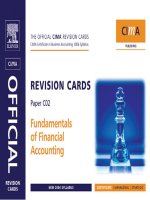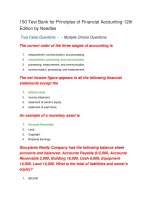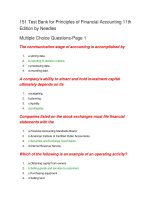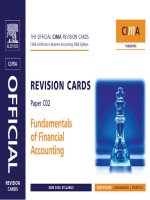Principles of financial accounting 12e by needles crosson chapter 14
Bạn đang xem bản rút gọn của tài liệu. Xem và tải ngay bản đầy đủ của tài liệu tại đây (375.08 KB, 22 trang )
CHAPTER
14
Long-Term Liabilities
Principles of
Accounting
12e
Needles
Powers
Crosson
©human/iStockphoto
Concepts Underlying Long-Term Liabilities
Lo ng -te rm liabilitie s are debts and obligations that a company
expects to satisfy in more than one year or beyond its normal
operating cycle, whichever is longer.
– Generally accepted accounting principles require that longterm liabilities be re cogniz e d and recorded when an
obligation occurs even though the obligation may not be
due for many years.
– Long-term liabilities are generally value d at the amount of
money needed to pay the debt or at the fair market value of
the goods or services to be delivered.
– A liability is clas s ifie d as long-term when it is due beyond
one year or beyond the normal operating cycle.
– Because of the complex nature of many long-term liabilities,
extensive dis clos ure in the notes to the financial statements
are often required.
©2014 Cengage Learning. All Rights Reserved. May not be scanned, copied or duplicated, or posted to a publicly accessible website, in whole or in part.
Types of Long-Term Debt
Bo nd payable —the most common type of long-term
debt; a more complex financial instrument than a
note; usually involves debt to many creditors
No te payable —a promissory note that represents a
loan from a bank or other creditor
Mo rtg ag e —a long-term debt secured by real
property; usually paid in equal monthly installments;
each payment includes interest on the debt and a
reduction in the debt
©2014 Cengage Learning. All Rights Reserved. May not be scanned, copied or duplicated, or posted to a publicly accessible website, in whole or in part.
Other Long-Term Obligations
Long-term leases—When a lease has a term that corresponds
closely to the life of the asset and, thus, is more like a purchase
of an asset than a shorter-term lease, it is called a c apital
le as e .
Pension liabilities—arise from contracts that require a company
to make payments to its employees have they retire.
Other post-retirement benefits—arise from contracts that
require a company to provide medical and other benefits to its
employees after they retire.
Deferred income taxes—result from using different accounting
methods to calculate income taxes on the income statement
and income tax liability on the income tax return; this is
considered a liability because these taxes will eventually have
to be paid.
©2014 Cengage Learning. All Rights Reserved. May not be scanned, copied or duplicated, or posted to a publicly accessible website, in whole or in part.
The Nature of Bonds
A bo nd is a security, usually long-term, representing money
that a corporation borrows from the investing public.
– A bond entails a promise to repay the amount borrowed,
called the principal, on a specified date and to pay interest
at a specified rate at specified times, usually semiannually.
– When a public corporation decides to issue bonds, it must
receive approval from the SEC to borrow the funds. The
SEC reviews the corporation’s financial health and the
specific terms of the bo nd inde nture , which is a contract
that defines the rights, privileges, and limitations of the
bondholders, including such things as the maturity date,
interest payment dates, and the interest rate.
– As evidence of debt to the bondholders, the corporation
provides each of them with a bo nd c e rtific ate .
©2014 Cengage Learning. All Rights Reserved. May not be scanned, copied or duplicated, or posted to a publicly accessible website, in whole or in part.
Bond Issue: Prices and Interest Rates
A bo nd is s ue is the total value of bonds
issued at one time.
– Prices of bonds are stated in terms of a
percentage of the face value, or principal, of the
bonds.
A bond issue quoted at 103 ½ means that a $1,000
bond costs $1,035 ($1,000 X 1.035).
When a bond sells at exactly 100, it is said to sell at
fac e value (or par value ).
A $1,000 bond quoted at 87.62 would be selling at a
discount and would cost the buyer $876.20
©2014 Cengage Learning. All Rights Reserved. May not be scanned, copied or duplicated, or posted to a publicly accessible website, in whole or in part.
Bond Issue: Prices and Interest Rates
The fac e inte re s t rate is the fixed rate of interest
paid to bondholders based on the face value of the
bonds.
The marke t inte re s t rate (or e ffe ctive inte re s t rate )
is the rate of interest paid in the market on bonds of
similar risk.
– The market interest rate fluctuates daily. This fluctuation
may cause bonds to sell at either a discount or a premium.
A dis c o unt equals the excess of the face value over the issue price.
The issue price will be less than the face value when the market
interest rate is higher than the face interest rate.
A pre mium equals the excess of the issue price over the face value.
The issue price will be more than the face value when the market
interest rate is lower than the face interest rate.
©2014 Cengage Learning. All Rights Reserved. May not be scanned, copied or duplicated, or posted to a publicly accessible website, in whole or in part.
Characteristics of Bonds
(slide 1 of 2)
Uns e c ure d bo nds (or de be nture bonds ) are issued
on the basis of a corporation’s general credit.
S e c ure d bo nds carry a pledge of certain corporate
assets as a guarantee of repayment.
When all bonds of an issue mature at the same time,
they are called te rm bo nds .
When the bonds of an issue mature on different
dates, they are called s e rial bo nds .
Callable bo nds give the issuer the right to buy back
and retire the bonds before maturity at a specified
c all pric e , which is usually above face value.
©2014 Cengage Learning. All Rights Reserved. May not be scanned, copied or duplicated, or posted to a publicly accessible website, in whole or in part.
Characteristics of Bonds
(slide 2 of 2)
– When a company retires a bond issue before its maturity
date, it is called e arly e xting uis hme nt o f de bt.
Co nve rtible bo nds allow the bondholder to
exchange a bond for a specified number of shares of
common stock.
Re g is te re d bo nds are issued in the names of the
bondholders. The issuing organization keeps a
record of the bondholders’ names and addresses
and pays them interest by check.
Co upo n bo nds are not registered with the
organization. Instead, they bear coupons that the
bondholder removes on the interest payment dates
and presents at a bank for collection.
©2014 Cengage Learning. All Rights Reserved. May not be scanned, copied or duplicated, or posted to a publicly accessible website, in whole or in part.
Using Present Value to Value a Bond
A bond’s value is determined by summing the
following two present value amounts:
– a series of fixed interest payments
– a single payment at maturity
The amount of interest a bond pays is fixed over its
life.
The market interest rate varies from day to day and
is the rate used to determine the bond’s present
value.
– Thus, the amount investors are willing to pay for a
bond varies because the bond’s present value
changes as the market interest rate changes.
©2014 Cengage Learning. All Rights Reserved. May not be scanned, copied or duplicated, or posted to a publicly accessible website, in whole or in part.
Using Present Value to Value a $20,000,
9 Percent, Five-Year Bond
©2014 Cengage Learning. All Rights Reserved. May not be scanned, copied or duplicated, or posted to a publicly accessible website, in whole or in part.
Amortizing a Bond Discount
(slide 1 of 2)
The bond discount affects interest expense each
year and should be amortized over the life of the
bond issue.
– To have each year’s interest expense reflect the market
interest rate, the discount must be allocated over the
remaining life of the bonds as an increase in the interest
expense each period. Thus, interest expense for each
period will exceed the actual payment of interest by the
amount of the bond discount amortized over the period.
This process is called am ortiz ation of the bond dis count.
– In this way, the unamortized bond discount will decrease
gradually over time, and the carrying value of the bond
issue (face value less unamortized discount) will increase
gradually. By the maturity date, the carrying value of the
bond issue will equal its face value, and the unamortized
bond
discount
be zero.
©2014 Cengage Learning.
All Rights
Reserved. Maywill
not be scanned,
copied or duplicated, or posted to a publicly accessible website, in whole or in part.
Amortizing a Bond Discount
(slide 2 of 2)
- The s traig ht-line me tho d equalizes amortization of a bond
discount for each interest period in the life of the bonds.
- The e ffe c tive inte re s t me tho d applies a constant interest
rate to the carrying value of the bonds at the beginning of
each interest period. This constant rate is the market rate
(i.e., effective rate) at the time the bonds were issued. The
amount amortized each period is the difference between the
interest computed by using the market rate and the actual
interest paid to bondholders.
– Ze ro c o upo n bo nds do not require periodic interest
payments. They are issued at a large discount because the
only interest the buyer earns or the issuer pays is the
discount.
©2014 Cengage Learning. All Rights Reserved. May not be scanned, copied or duplicated, or posted to a publicly accessible website, in whole or in part.
Amortizing a Bond Premium
Like a discount, a bond premium must be amortized
over the life of the bonds so that it can be matched to
its effects on interest expense during that period.
– The premium is in effect a reduction, in advance, of the total
interest paid on the bonds over the life of the bond issue.
– Under the straight-line method, the bond premium is spread
evenly over the life of the bond issue.
– With the effective interest method, the interest expense
decreases slightly each period because the amount of the
bond premium amortized increases slightly. This occurs
because a fixed rate is applied each period to the gradually
decreasing carrying value. This rate is based on the actual
market rate at the time of the bond issue.
©2014 Cengage Learning. All Rights Reserved. May not be scanned, copied or duplicated, or posted to a publicly accessible website, in whole or in part.
Retirement and Conversion of Bonds
Two ways a company can reduce its bond debt
are by:
– Retiring the bonds
Retiring a bond issue before its maturity date can be to a
company’s advantage. For example, when interest rates drop,
many companies refinance their bonds at the lower rate.
Bonds may be retired either by calling the bonds or by buying
them back from bondholders on the open market.
– Converting the bonds into common stock
When a bondholder converts bonds to common stock, the
company records the common stock at the carrying value of
the bonds.
The bond liability and the unamortized discount or premium
are written off the books. For this reason, no gain or loss on
the transaction is recorded.
©2014 Cengage Learning. All Rights Reserved. May not be scanned, copied or duplicated, or posted to a publicly accessible website, in whole or in part.
Sale of Bonds Between Interest Dates
When corporations issue bonds between interest
payment dates, they generally collect from the
investors the interest that would have accrued for the
partial period preceding the issue date.
– At the end of the first interest period, they pay the interest
for the entire period. In other words, the interest collected
when bonds are sold is returned to investors on the next
interest payment date.
– There are two reasons for this procedure:
It saves on the bookkeeping costs that would be required if the interest
due each bondholder had to be computed for a different time period.
When accrued interest is collected in advance, the amount is
subtracted from the full interest paid on the interest payment date, and
the resulting interest expense represents the amount for the time the
money was borrowed.
©2014 Cengage Learning. All Rights Reserved. May not be scanned, copied or duplicated, or posted to a publicly accessible website, in whole or in part.
Year-End Accrual of Bond Interest Expense
Bond interest payment dates rarely
correspond with a company’s fiscal year.
– Therefore, an adjustment must be made to accrue
the interest expense on the bonds from the last
interest payment date to the end of the fiscal year.
– In addition, any discount or premium on the bonds
must be amortized for the partial period.
©2014 Cengage Learning. All Rights Reserved. May not be scanned, copied or duplicated, or posted to a publicly accessible website, in whole or in part.
Long-Term Leases
A company can obtain an operating asset by:
– Borrowing money and buying the asset
– Renting the asset on a short-term lease (called an o pe rating
le as e )
The risks of ownership of the asset remain with the lessor (the owner),
and lease is shorter than the asset’s useful life.
– Obtaining the asset on a long-term lease
Accounting standards require that a long-term lease be treated as a
capital lease when it meets all of the following conditions:
– It cannot be canceled.
– Its duration is about the same as the useful life of the asset.
– It stipulates that the lessee has the option to buy the asset at a
nominal price at the end of the lease.
Structuring long-term leases in such a way that they do not appear as
liabilities on the balance sheet is called o ff-balanc e -s he e t financ ing .
©2014 Cengage Learning. All Rights Reserved. May not be scanned, copied or duplicated, or posted to a publicly accessible website, in whole or in part.
Pension Liabilities
A pe ns io n plan is a contract that requires a company to pay
benefits to its employees after they retire.
– The contributions from employer and employees are usually
paid into a pe ns io n fund, which is invested on behalf of the
employees.
– There are two kinds of pension plans:
De fine d c o ntributio n plan—The employer makes a fixed
annual contribution, usually a percentage of the employee’s
gross pay. Retirement payments vary depending on how much
the employee’s retirement account earns.
De fine d be ne fit plan—The employer contributes an amount
annually to fund estimated future pension liability.
– Employers whose pension plans do not have sufficient assets to
cover the present value of their pension obligations must record
the amount of the shortfall as a liability.
©2014 Cengage Learning. All Rights Reserved. May not be scanned, copied or duplicated, or posted to a publicly accessible website, in whole or in part.
Evaluating the Decision to Issue
Long-Term Debt
Issuing common stock has two advantages over issuing long-term
debt:
– Permanent financing—Common stock does not have to be paid back.
– Dividend payment is optional.
Issuing long-term debt, however, has the following advantages:
– Common stockholders do not relinquish any of their control over the
company because bondholders and creditors do not have voting rights.
– The interest on debt is tax-deductible, whereas dividends are not.
– If a corporation earns more from the funds it raises by incurring long-term
debt than it pays in interest on the debt, the excess will increase its
earnings for the stockholders. This concept is called financ ial le ve rag e .
Financial leverage is advantageous as long as a company is able to
make timely interest payments and repay the debt at maturity.
Because failure to do so can force a company into bankruptcy, a
company must assess the financial risk involved.
©2014 Cengage Learning. All Rights Reserved. May not be scanned, copied or duplicated, or posted to a publicly accessible website, in whole or in part.
Debt to Equity Ratio
To assess how much debt to carry, managers
compute the de bt to e quity ratio , which shows
the amount of debt a company carries in relation
to its stockholders’ equity. The higher this ratio,
the greater the financial risk.
©2014 Cengage Learning. All Rights Reserved. May not be scanned, copied or duplicated, or posted to a publicly accessible website, in whole or in part.
Interest Coverage Ratio
The inte re s t c o ve rag e ratio measures the degree
of protection a company has from default on interest
payments. The lower the ratio, the greater the
financial risk.
©2014 Cengage Learning. All Rights Reserved. May not be scanned, copied or duplicated, or posted to a publicly accessible website, in whole or in part.









